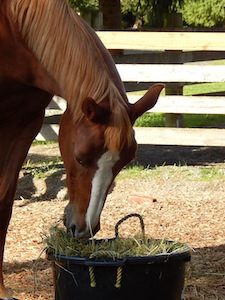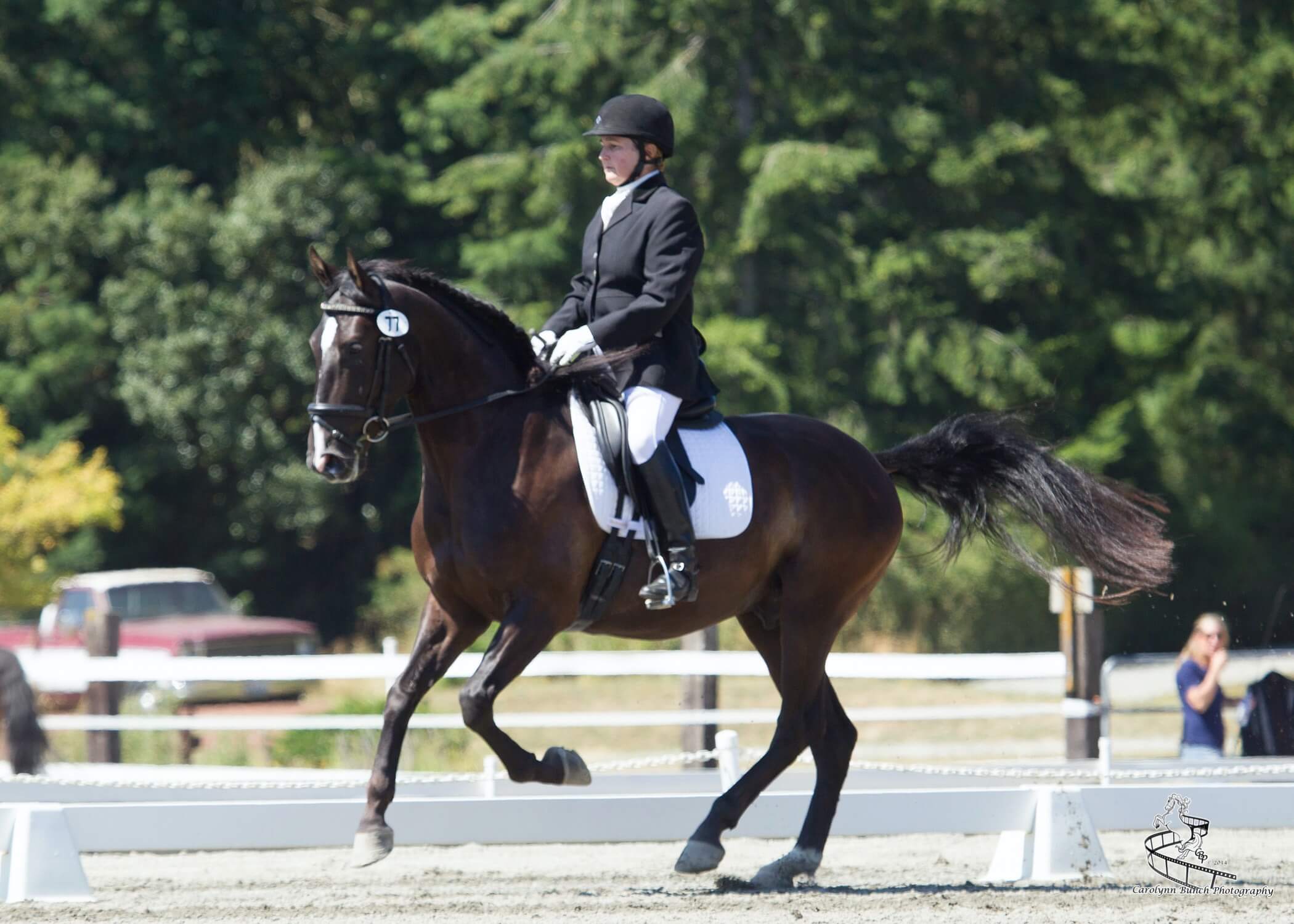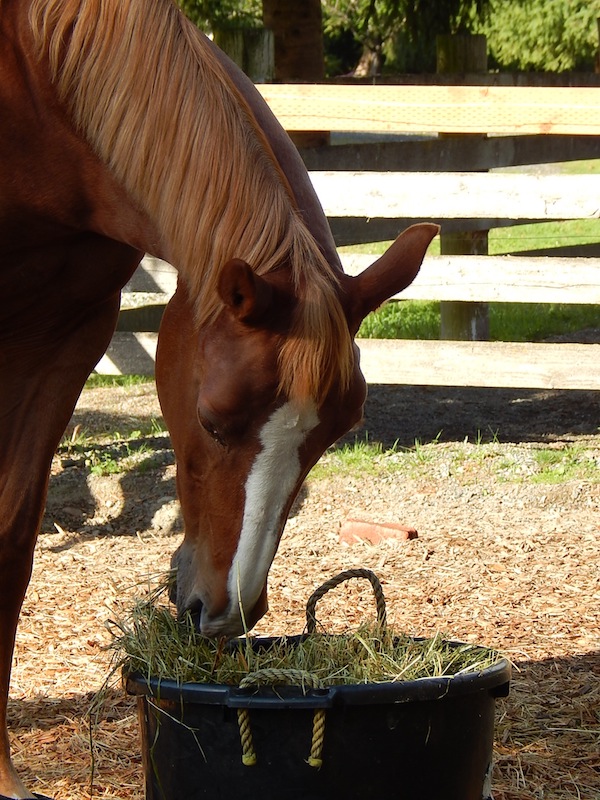Poison in Your Feed Bag
by Kim Roe

One of the joys of horse ownership is pouring grain or concentrates into a bucket and offering it to a happy horse. Concentrates provide our horses with important nutrients and calories they might not otherwise receive. We trust that the ingredients listed on feed labels are what actually ends up in our horses. Studying feed labels allows us the comfort and assurance that we are feeding our horses correctly. Unfortunately, the controls often seen in human foods are not as strictly adhered to in animal feed, and the result can be devastating.
Recently, The Northwest Horse Source was contacted by a trainer with a terrifying story. She had recently lost four horses to violent and painful deaths. It appears the horses died from ionophore toxicosis. Ionophores are chemicals added to other species’ feeds, generally cattle or chicken feed. This is why horses should never be fed feed intended for other species. The most common ionophores are monensin and lasalocid. Those feeds are sold as medicated feed; the ionophores increase weight gain in some animals. The poisons dissipate quickly within a horse’s system — almost before any outward signs can be seen, making ionophore toxicosis difficult to diagnose.
Due to impending litigation, we can’t use the trainer’s name. It is important to note that she was not feeding cattle or chicken feed to her horses; her belief is that the feed company accidently mixed some ionophore-laden feed into her equine feed. Our hope is to educate readers and help prevent more tragedies from occurring. Here is her story.
One morning my 5-year-old son let the dog out and said to me, “Mom your horse is lying on the fence.” I looked out and saw that my 8-year-old Thoroughbred gelding was in fact lying on the fence. I ran outside and saw he was covered with sweat, but cold to the touch, with a small amount of blood coming out of his nose. At first, I thought he was dead. However, when I touched him he got up and walked over to the indoor ring and started walking around. I made the assumption he had colicked, so I closed the gate after putting some water in a bucket for him.
I checked on him throughout the day to see if he was drinking and still walking. He walked for a couple of hours then casually grazed around for small morsels of hay. It appeared the problem had passed, and by feeding time I felt he looked bright and well enough to get back to routine. I put him in his stall and fed him as normal.
While I was feeding, one of the other geldings started trying to go through the walls of his stall. I immediately brought him into the indoor arena and he went down. A few minutes later I saw him get up, walk like a zombie to the end of the arena, flip over the fence at the end of the ring and fall into the ditch. I immediately called my husband and the vet.
We tore apart the fence so we could get him up, out, and back into the ring. As soon as the vet arrived she gave him a sedative. One sedative was not enough. As the vet was heading back to her truck for more, the gelding did a 360-degree turn in the air in front of me and then collapsed. At this point we decided to euthanize him.
The vet told me this was the worst colic she had ever seen and suggested we send him for a necropsy. I described to the vet what had happened with my other gelding that morning. How could I have two colics in the same day?
In the morning, while dropping one of my children off at daycare, I got a phone call from one of my students telling me my gelding had died. He had gone through the stall wall into the next stall. The stall was covered in foam and looked like a soapy washing machine had overflowed. I immediately knew we had a major problem.
I sent both horses for necropsies. We knew there was a toxin somewhere. My helpers and I scrubbed every water bucket, hay bin, halter and lead rope. Every possible shared item was bleached and disinfected.
The vet and I investigated all unknown plants, the grain, the hay—everything was immediately sent for testing. We also started monitoring heart rates, breathing rates, and temperatures on the remaining horses; all seemed well. At this point the vet leaned towards the horses eating rat poison or contaminated feed based on the symptoms and bloodwork results. I didn’t use rat poison.
The result of the necropsies pointed to ionophores. We continued to monitor vital signs on the remaining horses. I cancelled lessons and closed the farm.
The next morning, I noticed our stallion was off. He had increased vitals, so we did a troponin test (a blood test that measures an enzyme the heart produces when it is damaged). His was abnormally high. We put him on IV fluids and hoped for the best.
All seemed to be going well until that evening when I needed to run to the vet to get more fluid bags. When I arrived back home he had bubbles coming out of his nose and mouth. You could tell that he was having trouble breathing. When the breathing got too difficult, he literally went into seizures throwing himself against the stall walls, coating them with foam. He died right in front of me and there was nothing I could do. The vet couldn’t get there quickly enough.
Those two days were some of the darkest I’ve ever experienced, and it wasn’t over. We thought after 48 hours we would be free and clear. I spent the next couple of days on the phone with experts in ionophores, toxicologists, internal specialists, and pathologists. I spent hours reading veterinary notes and cases on ionophores since I simply could not grasp that it was possible for poison to be in my horse’s feed.
A few days after the initial exposure, we had another horse tie-up and develop the same symptoms. All the specialists thought the toxin was still there and the horse had been re-exposed. I was ready to euthanize rather than see another horse suffer, but luckily my vet convinced me to let her go through the night and she pulled through.
We did lose one more horse—a superb lesson horse. We believe it was the result of the aftereffects of the toxin.
I seriously encourage horse owners to know what is or could be in their horses’ feed. I strongly encourage you to purchase grain from an ionophore-free mill so that you won’t have to live through the nightmare we experienced.
Originally Published October 2017 Issue

Kim Roe grew up riding on the family ranch and competed in Western rail classes, trail horse, reining, working cow, and hunter/jumper. She trained her first horse for money at 12 years old, starting a pony for a neighbor.
Kim has been a professional dressage instructor in Washington state for over 30 years, training hundreds of horses and students through the levels. In recent years Kim has become involved in Working Equitation and is a small ‘r’ Working Equitation judge with WE United.
Kim is the editor of the Northwest Horse Source Magazine, and also a writer, photographer, and poet. She owns and manages Blue Gate Farm in Deming, Washington where she continues to be passionate about helping horses and riders in many disciplines.






